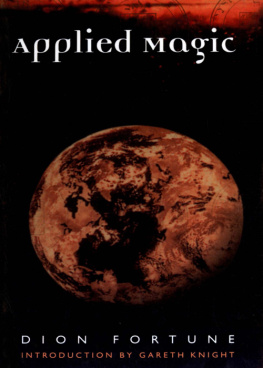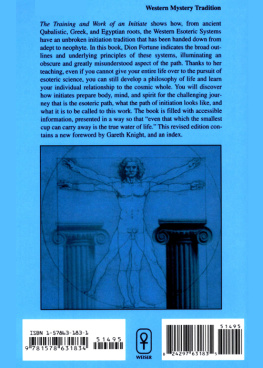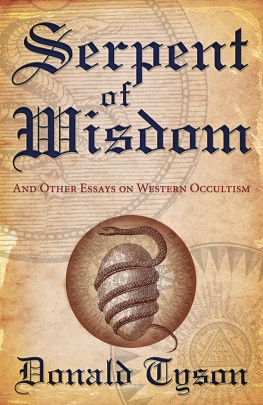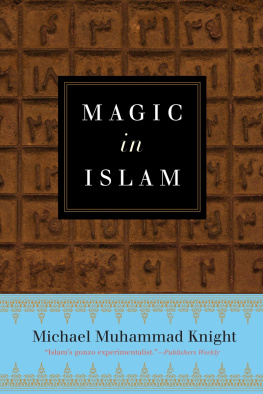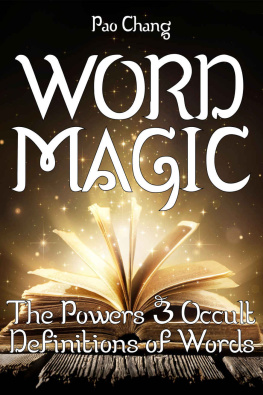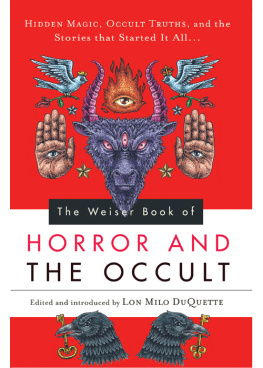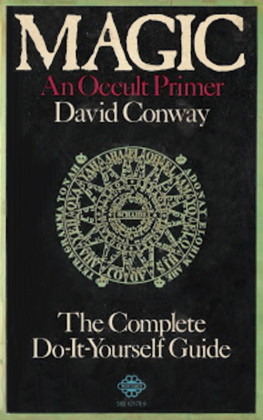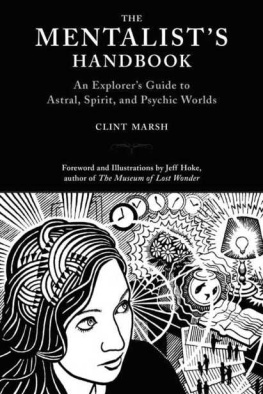Other books by Dion Fortune
Occult Study
Machinery of the Mind
The Esoteric Philosophy of Love and Marriage
Psychology of the Servant Problem
The Soya Bean
Esoteric Orders and Their Work
The Problem of Purity
Sane Occultism (to publish as What is Occultism? Weiser, 2001)
Training and Work of an Initiate
Mystical Meditations on the Collects
Spiritualism in the Light of Occult Science
Psychic Self-Defense
Through the Gates of Death
GlastonburyAvalon of the Heart
The Mystical Qabalah
Practical Occultism in Daily Life
Applied Magic
Aspects of Occultism
The Magical of Britain
Occult Fiction
The Demon Lover
The Goat-Foot God
Moon Magic
The Sea Priestess
The Secrets of Dr. Taverner
The Winged Bull

First published in 2000 by
Red Wheell Weiser, LLC
York Beach, ME
With offices at
368 Congress Street
Boston, MA 02210
www.redwheelweiser.com
10 09 08 07 06 05 04
10 9 8 7 6 5 4 3 2
Text copyright 1962 Society of the Inner Light
Introduction copyright 2000 Samuel Weiser, Inc.
All rights reserved. No part of this publication may be reproduced or transmitted in any form or by any means, electronic or mechanical, including photocopying, recording, or by any information storage and retrieval system, without permission in writing from Red Wheel/Weiser, Reviewers may quote brief passages.
Dion Fortuner is a registered trademark
Library of Congress Cataloging-in-Publication Data
Fortune, Dion.
Applied Magic / Dion Fortune.
p. cm.
Originally published: London: Aquarian Press, 1962 with new Introd.
Includes index.
ISBN 1-57863-185-8 (pbk : alk. paper)
1. Occultism. I. Title.
BF1411 .F554 2000
133dc21 00-040893
Printed in the United States of America
BJ
The paper used in the publication meets the minimum requirements of the American National Standard for Permanence of Paper for Printed Library Materials Z39 .48-1992(R 1997).
www.redwheelweiser.com
www.redwheelweiser.com/newsletter
CONTENTS
INTRODUCTION
by Gareth Knight
A PPLIED MAGIC is a collection of articles culled from Dion Fortune's Inner Light Magazine which was published from October 1927 through August 1940. Its columns were largely filled by Dion Fortune, herself. In its columns some of her great works, such as The Mystical Qabalah, first saw the light of day. It also contained many shorter pieces, written at the spur of the moment to meet a deadline, but which deserve preservation within the covers of a book. Hence this collection and its companion volume, Aspects of Occultism.
Dion Fortune's vision of occultism was a very practical one, and as she explains in her chapter, The Occult Way, it is one based upon life experience. She had little time for a life-denying style of mysticism that looks down upon the outer world as an arena from which to try to escape. There were plenty of high minded in effectuals on the esoteric scene in her day, and indeed at one point she gave up a series of afternoon lectures because they were attended solely by nice-minded gentlefolk of the leisure class. The species is largely extinct through economic forces these days, although the attitude lives on in other social guises.
While it may seem to be a counsel of perfection to try to obtain mastery over every aspect of created life, which was her idea of a Master, the way toward to such a state was not by withdrawing from life but rather by seeking to live it more abundantly. If the object of created life is for the human spirit to express itself within the worlds of form, through a process of personal spiritual evolution, it is hardly likely to be achieved by turning away from natural life. Thus the Path of the Hearth fire, as she called it, involving the responsibilities of family life, was a sound and effective part of any initiate's training.
This might be gathered from those historical characters whom she considered to have been, if not Masters in life, then upon the verge of becoming such in their last incarnate personality. Of these she cited Socrates, a wise man but a very down to earth one, likened to Silenas, a follower of Dionysus's drunken rout; Thomas Erskine, a lawyer and champion of human liberty in the face of conservative reaction against the French Revolution and the American War of Independence, and also an early champion of animal welfare, but lampooned as Sir Ego by his opponents; David Carstairs, a contemporary idealistic middle class young man who devoted himself to youth work before meeting his death on the Ypres salient in the World War I. None of them were ascetic gurus of the withdrawn kind.
In practical terms of our esoteric aspirations in the here and now, the key element is one of motive, and as Dion Fortune saw it, the one great disqualification from going very far along the occult path was because, finding life too difficult, we want to escape forever from its problems.
In Some Practical Applications of Occultism she gives a very succinct resume of just what training upon the occult path involves. Fortunately, most of the veils of secrecy that she had to put up with are no longer the barrier they once were, and some of the credit for pulling them down rests with people like herself and Israel Regardie, as she goes on to discuss in The Occult Field Today. Of the more popular revelations of esoteric teaching, such as the Spiritualist Movement and Christian Science, she had considerable experience at various times in her life.
Her parents had been keen members of the Christian Science church, and her mother, Jennie Firth, had for some years been a registered healer within it. Not a great deal of this rubbed off on Dion Fortune, in fact rather the reverse seems the case, for in 1922 the Firths gave up Christian Science and removed to Letch worth. There they became associated with the garden city movement and the promotion of soya as a vegetarian alternative to dairy products, with a certain amount of mediumistic advice from their daughter, who had recently been developing these capabilities.
Records of Dion Fortune's medium ship in one form or another exist to cover most of the time between 1921 and 1945. She felt that her own type of work in this direction was not quite the same as most spiritualist mediums however, and in 19291930, she wrote a series of articles in her magazine to say so, under the title of Spiritualism in the Light of Occult Science. Some of this material appears in this volume under the heading of The Inhabitants of the Unseen in The Three Kinds of Reality. This caused a certain amount of upset within spiritualist circles at the time, particularly in the light of a series immediately following, called Through the Gates of Death, which contained some criticism of the indiscriminate calling back of the departed. Through the Gates of Death (Weiser, 2000) is now once more available and its strictures would seem no more than common sense precautions to most intelligent spiritualists, while the earlier work, re-titled Spiritualism and Occultism (Thoth, 2000) now includes much of Dion Fortune's ancillary writing on techniques of trance as well as an account of her attempted rapprochement with the spiritualist movement in 1942, when she envisaged a united front against the forces of materialism in the post-war epoch. These ideals, it seems, were either unrealistic or somewhat premature, and hardly lasted into 1943 before foundering on entrenched positions of mutual distrust.
Next page
